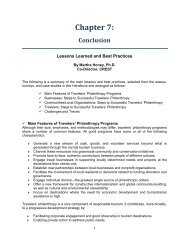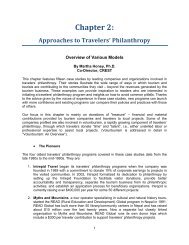Travelers' Philanthropy Handbook - Center for Responsible Travel
Travelers' Philanthropy Handbook - Center for Responsible Travel
Travelers' Philanthropy Handbook - Center for Responsible Travel
Create successful ePaper yourself
Turn your PDF publications into a flip-book with our unique Google optimized e-Paper software.
sustained local communities by targeting several priority areas <strong>for</strong> development andconservation at the same time. The areas where health, climate and energy, poverty reductionthrough job creation and conservation of wildlife, i.e. all within community defined need areaswith a plan <strong>for</strong> implementation.So what was the problem? The family foundation that was interested in funding the projectwanted a quick proposal against which it could disperse a donation be<strong>for</strong>e end year in order toactivate its annual quota of funds. However, looking at some of the internal aspects ofBasecamp Foundation’s organization at the time, there was no guarantee it could mobilizeenough human resources in order to give a guarantee to finish the project in time. As temptingas it was to say yes to a relatively large donation -- $50,000, we made the decision to ask <strong>for</strong> anopportunity to apply the following year – knowing there would be competition over priorities andnew project proposals. How did it end? Eventually the funding was approved in the followingyear’s budget. The project started on time and is now near completion. One of the donor boardmembers later mentioned that a significant factor in winning approval was the fact thatBasecamp had originally said “No” and outlined its logic <strong>for</strong> doing so. This, the board membersaid, helped instill trust in the transparency and governance structure of Basecamp Foundation.3. Spread Too ThinSpread too thin is perhaps the least worrying of the fiveaspects behind rejecting funding. The worst-case scenariois that the project has little drive and delivers below itspotential. To exemplify this, let’s take the example of one ofBasecamp’s gender sensitive projects, the BasecampMaasai Brand (BMB). BMB has been up and running <strong>for</strong>over six years. It engages more than 100 Maasai women intraining and awareness building around traditional Maasaihandicrafts. The women represent the six poorest villagesaround Basecamp’s Mara destination and the project alsoprovides a plat<strong>for</strong>m <strong>for</strong> learning and understanding of deepcultural values. At the same time, issues such asenvironmental sustainability, HIV/AIDS, and microfinance are integrated in the training. Theproject is global fair-trade certified and the women keep a major portion of the money fromselling their artifacts. The quality is high and a proof to that is that ABC Carpet & Home in NewYork City took some of the products into their collection in 2008.However, Basecamp has spread itself thin in relation to the huge untapped potential imbeddedin the BMB project. The project is by no means a disaster, but is clearly delivering below itspotential. BMB has in its lifetime generated about $150,000 in direct income <strong>for</strong> the women.Given the quality of the work and its inclusion in the collection of a major New York design anddecoration firm, the project’s potential income generating capacity is estimated to be three tofive times higher. Why is it not delivering? Given that the BMB project was competing with over30 other Basecamp projects that needed attention within the same time period, the resourcesrequired to develop new international markets and distribution channels was simply not there.When you spread too thin, you will rarely realize the full potential and depth of a project.4. Over-ReportingIt may be argued that “over-reporting” is a less common problem than “under-reporting,” i.e. thatwe disregard the importance of staying in touch with our donors and as a result lose out onreceiving renewed support. However, when conservation organizations, philanthropicfoundations, or even governments through their aid and development organizations finance your127BMB Fair Trade Maasai Crafts, Kenya.Credit: Basecamp Foundation















